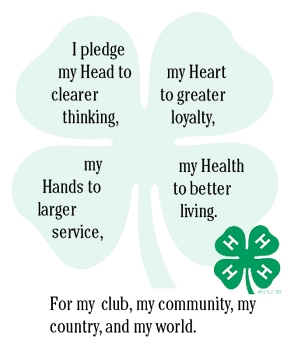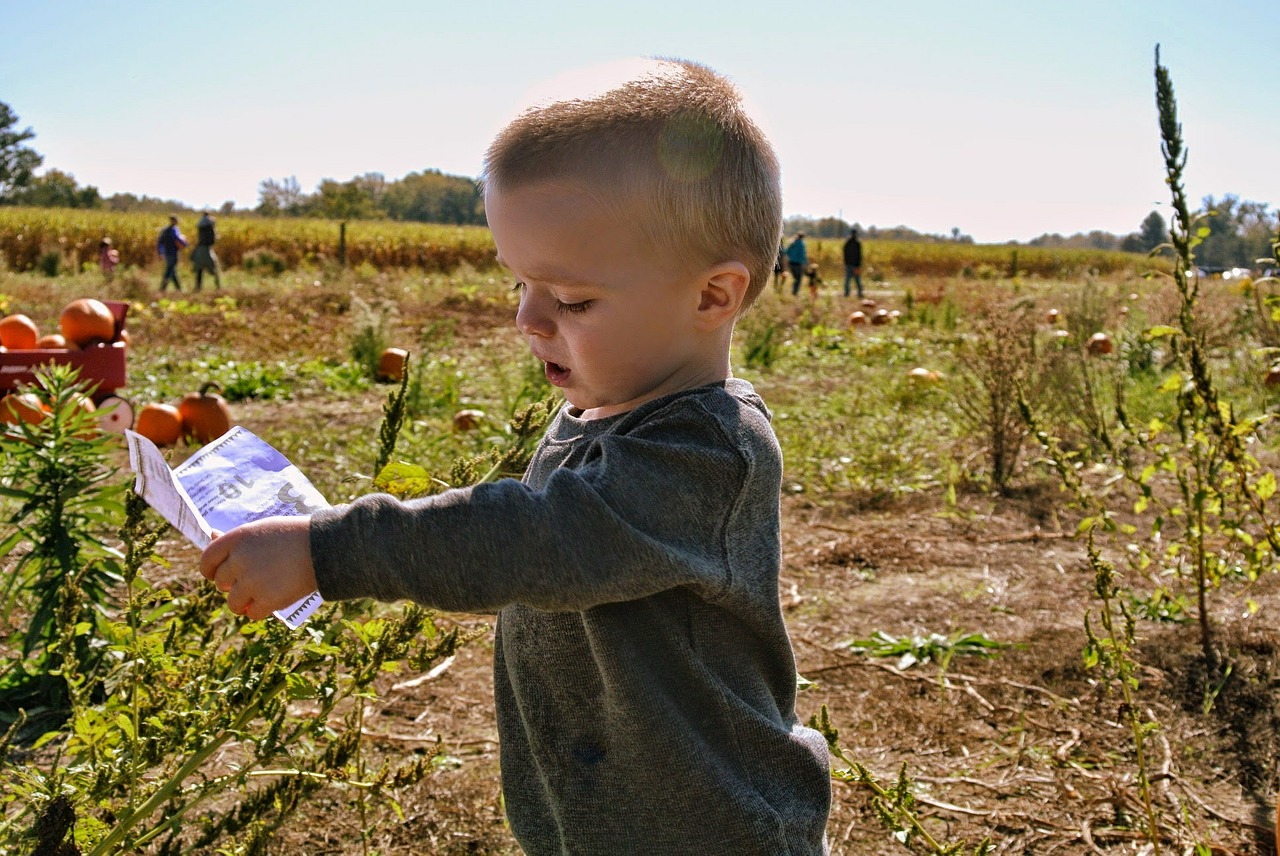A small pale boy with a crewcut scowls as he holds his goat at a county fair. A young girl in green offers lettuce plants that look nearly dead in the sunlight. Pale children with grim faces stand in stark poses with their livestock.
The photos illustrate a recent Modern Farmer article entitled “4-H: Indoctrination Nation.”
4-H is one of the largest youth development organizations in the United States, involving nearly 6 million youngsters ages 8 to 18 across the nation.
It began in the early 1900s as a club for farm kids, but today about one-third of its members are from urban areas, one-third from the suburbs and one-third from rural areas, said Lisa Lauxman, director of the youth and 4-H division in the U.S. Department of Agriculture.
Youngsters take part in a wide variety of hands-on projects — ranging from robotics to science experiments to artwork to showing livestock at the county fair — intended to help them develop life skills. 4-H has expanded far beyond farming-related projects, but it’s still a major opportunity for farm kids.
Today, 4-H accepts millions of dollars from big agriculture corporations, the Modern Farmer article said, implying that the organization represents the interests of those companies. And as a U.S. Department of Agriculture-funded organization, it has always been a propagandist, according to the article, pushing new seeds, crop subsidies, patriotism in World War II and agribusiness interests overseas.
Furthermore, the organization promoted gender stereotypes in the past and was racist, the article said.
Indoctrination nation?
Does 4-H, in fact, indoctrinate young people?
No, said Lauxman. 4-H has looked quite different over time and it means a lot of different things to different people, she said.
“Its mission has always been to translate science to the local community,” she said.
“The article cherry-picked facts,” said Don Nicholson, interim associate 4-H program leader at the 4-H Center for Youth Development in Columbia, Missouri. “I don’t disagree with the facts, but they’re strung together to imply a conspiracy.”
He has been with 4-H and the Cooperative Extension Service for 39 years, he said.
“4-H does not advocate a particular form of [agricultural] production,” he said.
“It reflects local sensibilities and local awareness,” Nicholson said. “There’s a fair bit of variation from region to region and state to state.”
The common core value that 4-H has is developing youth, he said.
Out of the past
4-H began in the early 1900s, a time when land-grant universities were trying to get their new research out to farmers, who were often resistant. They weren’t necessarily interested in doing soil testing and using new seed varieties.
University researchers reached out to school systems to start youth clubs. The clubs sought to sway farming practices, to modernize farms and increase crop yields.
In 1914, a partnership was set up between the U.S. Department of Agriculture and land-grant universities to extend their research and education to communities and farmers. Known as the Cooperative Extension System, this partnership now provides 4-H programming through 110 land-grant universities across the country and through thousands of volunteer leaders.
4-H is funded through the USDA, which spent $68 million on youth development in 2015, according to the writer of “4-H: Indoctrination Nation,” Sarah McColl. 4-H is also funded through the nonprofit National 4-H Council, which spent approximately $48 million last year, according to its annual report.
Sarah Gray Miller, the editor of Modern Farmer, defends the article.
“The headline [‘4-H: Indoctrination Nation’] certainly references the role 4-H played in helping the USDA carry out New Deal legislation, including federal crop subsidies, through the work of Depression-era extension agents, who spent 30 to 40 percent of their time on youth outreach.” Miller wrote in an email.
There’s a difference, however, between policy and indoctrination.
Introducing new ideas in the early 1900s using youth may have been “sneaky,” Nicholson said, but it was not indoctrination.
The role of 4-H in modernization
Fred Iutzi is president of the Land Institute in Salinas, Kansas, a nonprofit sustainable farming center working to develop alternatives to what it sees as current destructive agricultural practices.
4-H was involved in the “modernization” of farming, Iutzi said.
“4H came out of the same matrix of a lot of … organizations “ such as Farm Bureau [the American Farm Bureau Federation] and the state Cooperative Extension services, Iutzi said.
 “The organizations co-evolved,” he said. There were a lot of related initiatives, such as making farms more explicitly science-driven, adopting the practices of other kinds of businesses and professionalizing farming rather than valuing the grassroots knowledge of farmers, he said.
“The organizations co-evolved,” he said. There were a lot of related initiatives, such as making farms more explicitly science-driven, adopting the practices of other kinds of businesses and professionalizing farming rather than valuing the grassroots knowledge of farmers, he said.
4-H reflected its times. Girls were treated differently than boys and black children were in separate clubs.
Miller pointed out that the article does not say that 4-H is currently sexist. The article says 4-H National Program Leader Jim Kahler “insists” that racial discrimination is a thing of the past. But the article raises its eyebrows without providing any evidence for its skepticism.
Iutzi noted that the 4-H of today has space to pursue goals like gender and ethnic diversity and alternatives to conventional farming, just as author McColl acknowledged.
Nicholson said 4-H has been through many changes.
“As the nation has evolved, so has 4-H,” he said. “We look back at the ’40s and ’50s and wonder about some of the practices.”
Why it’s important: Agribusiness vs. sustainable farming
But what is 4-H’s role today in promoting various farming practices?
The question takes on particular importance in the context of a struggle in agriculture over sustainability.
U.S. farm policy has produced a system of large-scale industrial agriculture that is not sustainable, according to critics such as the Union of Concerned Scientists.
Most farmland in the United States is covered by single-crop farms that use many chemicals in food production, according to the organization. This method of production, developed after World War II, is criticized for its heavy use of pesticides and its reliance on fertilizers that pollute waterways.
It’s wearing out the soil and causing environmental damage, according to the union. Current practices harm the environment, public health and rural communities, it says.
Midsized family farms cannot compete and are going out of business, leaving many rural communities in decay.
The Land Institute is one of the organizations seeking solutions.
“We have to tap into local knowledge” from farmers, rural community members, urban community members, scientists, scholars, the Extension Service and others, Iutzi said.
“Our approach is we have to take into account all the ways agriculture interpenetrates into natural systems.”
Iutzi grew up on a crop and livestock farm in Hamilton, Illinois. He was in 4-H for several years in middle school.
“I focused on electricity, model rocketry and photography,” he said.
“4-H is a way for young people to make an inquiry or study of particular topics in agriculture,” he said. “Doing a 4-H project can be a way for someone to deeply approach [subjects of] conventional agriculture or of alternative or sustainable agriculture.”
Encouraging inquiry
When Dorothy McCargo Freeman stands up in front of a room of 4-H participants, which is often, “I ask questions,” she said. “They come to their own conclusions.
“We teach young people how to think, not what to think,” said the associate dean and state 4-H director at the University of Minnesota Extension.
Lauxman, director of the USDA youth and 4-H division, said that young people become engaged in their local communities through 4-H and become change agents.
“4-H has always had the opportunity to provide for diversity of thought,” she said. “You’re going to find youth involved in organic gardening, large-scale farming and niche farming.”
Katie Ellis has a slightly different view. “I have not seen a sustainable focus in 4-H,” she said.
“Looking back I see how conventional the mindset was and how conventional it remains.” She grew up on a farm in Boyle County, Kentucky, raising hogs and tobacco and was involved with 4-H from age 9 to 18. She showed hogs and loved being part of 4-H.
Ellis is now managing director at The Berry Center in New Castle, Kentucky, where “we’re looking to bridge that gap.” It’s a nonprofit devoted to “changing our ruinous industrial agriculture system” into one that respects nature, prevents damage to the ecosphere and creates healthy local farming communities.
“It’s easy to fall into the conventional way of things,” she said. “We see this with the land-grant universities and with extension.” For example, she said she has known some extension agents to balk at the idea of organic produce.
However, activities of the extension service at the local level can often “run counter to that,” she said.
“Our agricultural extension agent works with youth in the county to talk about the production of livestock, grazing and a host of conditions to incentivize good husbandry,” Ellis said. “Those are very important on the local level.”
“He’s finding a way to engage youth in his work,” she said. “We have to look for the people who are encouraging good practices and encouraging farmers to create a local market.”
Looking at the money
In any discussion of sustainable farming, the real question may be about the power and influence of agribusiness interests across the United States.
While agriculture and other large companies provide significant funding for 4-H, major donors at the national level also include the Robert Wood Johnson Foundation, the Bill and Melinda Gates Foundation and the New York Life Foundation.
As writer Sarah McColl noted, donations are made at the national, state and local levels, making it difficult to trace the influence of money.
Corporate donors don’t dictate a particular type of agricultural production, said Nicholson, of the 4-H Center in Columbia. Donations go to leadership development, service projects and career and life skills development for kids, he said.
4-H programs are about developing life skills, he said. They start with a young person’s interests, whether it’s rocketry or crop production. In pursuing their interests, young people develop self-esteem, empathy with others and other qualities, Nicholson said.
“Those are the values at the center of 4-H,” he said.































